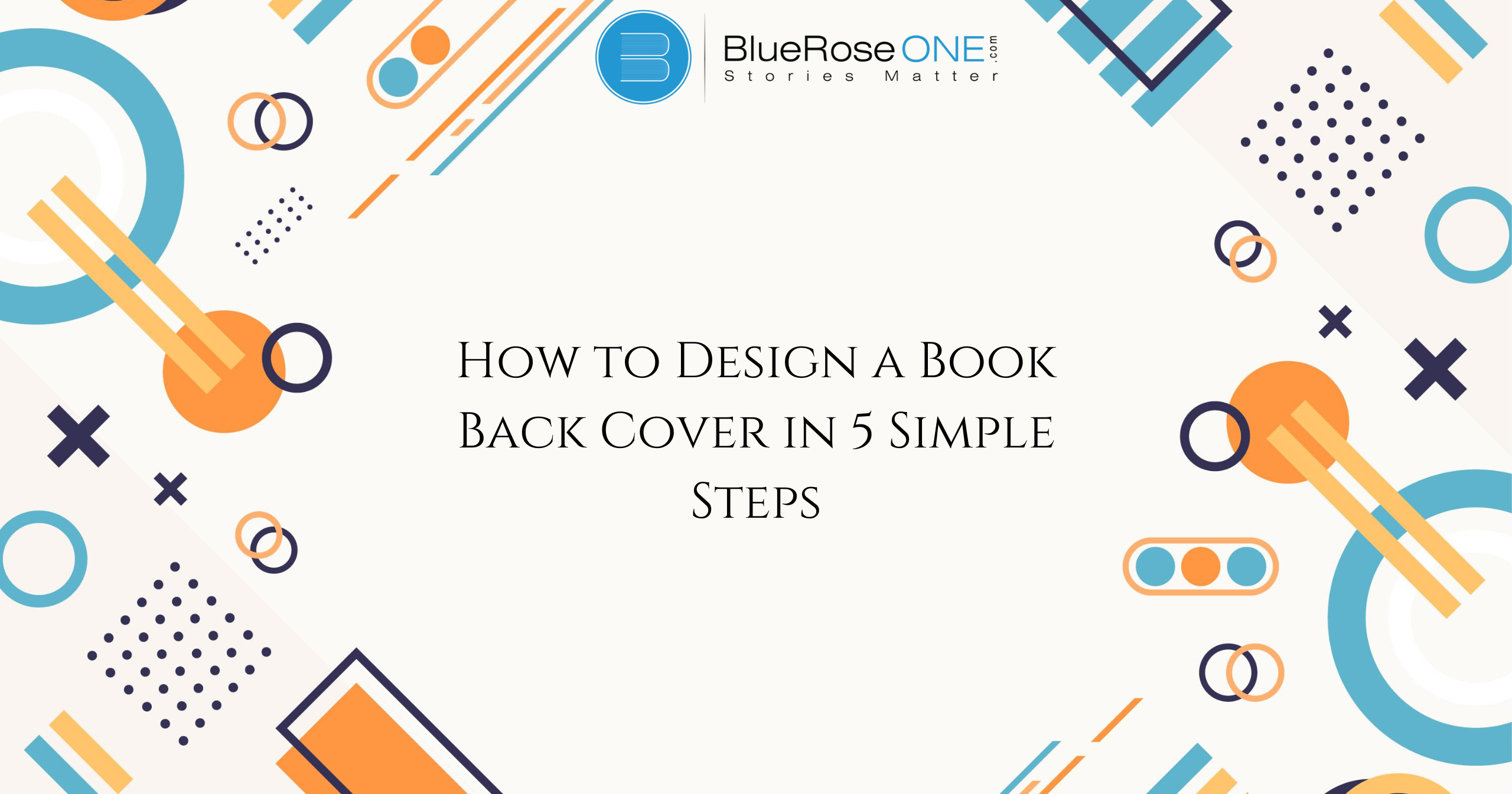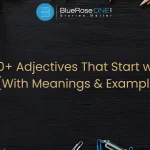Creating an eye-catching and effective book back cover is crucial for grabbing readers’ attention and sealing the deal on a potential sale. The back cover serves as the silent salesperson for your book, offering just enough intrigue to make someone flip through the pages. This guide will walk you through five easy steps to design a book back cover that draws readers in, communicates your message, and complements your book’s style. Let’s dive in!
Why Book Back Cover Matters
When it comes to book promotion, the back cover of your book is a valuable asset. Prospective readers go there to determine whether or not they want to accept the risk. More than just drawing attention, a well-designed back cover increases reader trust and corresponds with their expectations of the book’s content. Let’s dissect the procedure to ensure that your back cover performs as intended.
You may also like: How to Publish a Book? | Publish Your Book | BlueRoseOne
Step 1: Understand the Key Elements of a Back Cover
Before you start designing, it’s important to know the main components of a successful book back cover. These include:
Book blurb: A book blurb is a brief, alluring synopsis that provides readers with an overview of the subject or tale on the back cover. It is designed to pique interest without giving away too much, usually emphasizing the book’s central characters, conflict, or distinctive elements. A strong blurb appeals to the book’s intended audience by capturing the genre and tone. It serves as a kind of mini-trailer, luring readers in to see what occurs next in the novel.
Tagline: A tagline is a short, catchy phrase on the book back cover that grabs the reader’s attention and hints at the book’s theme or main idea. It’s like a mini-hook designed to intrigue readers and make them curious about what’s inside. An effective tagline is brief often just a few words but powerful, giving a taste of the story or message. Think of it as the book’s first impression, setting the tone and drawing readers in for a closer look.
Author bio and photo:A book’s back cover must have an author bio and photo to give readers a glimpse of the person who wrote the novel. The author’s writing accomplishments, pertinent history, or a personal story that relates to the book’s theme are usually included in a brief biography. By providing a personal touch, the author photo enables readers to identify with the author. For prospective readers, the book back cover can be made more welcoming and memorable by combining a professional, personable photo with a succinct, interesting bio.
Design elements:The design elements of a book back cover play a crucial role in attracting readers’ attention. Key elements include a captivating tagline, a brief book description, and endorsements or reviews. Visual components, such as complementary colors, fonts, and images, enhance the back cover’s appeal and align with the book’s overall theme. These design elements not only provide essential information but also create a lasting impression, encouraging potential readers to pick up the book and explore further.
Barcode and ISBN: The barcode, which often includes the book’s ISBN (International Standard Book Number), is an essential component of every book back cover. The ISBN is a special identification number that makes it simple for readers, libraries, and bookshops to locate and buy the book. For both physical and online merchants, having the barcode on the back cover guarantees that your book may be scanned at the point of sale. The accessibility and marketability of your book are greatly increased by this minor addition to the rear cover.
Together, these elements work to create a cohesive, attractive design.
You may also like: What is a Preface? Key Characteristics with Examples
Step 2: Craft a Compelling Blurb
Your book blurb should give readers a taste of the story without revealing too much. Here’s how to write an effective one:
Start with a hook: When writing a captivating blurb for your book’s back cover, begin with an attention-grabbing hook. Readers should be piqued by the opening sentence, which should hint at the excitement or interest of the book. This hook, which alludes to the story’s central conflict or distinctive setting, can be a daring declaration, a query, or an engrossing scene. You can entice people to turn the pages and learn more about your book by grabbing their attention with an engaging opening.
Highlight key themes or conflicts: When writing an engaging book back cover blurb, emphasizing important themes or conflicts can draw readers in right away. You can build suspense and highlight the story’s emotional stakes by providing a preview of the primary conflicts or concepts. The plot and characters are more relatable to readers because of this technique, which increases their curiosity about the story’s development. A well-written blurb on the book’s back cover may be a very effective strategy for drawing in new readers, so be succinct but striking.
Keep it short and sweet: Keep it brief and to the point when writing an engaging blurb for your book’s back cover. Without overwhelming the reader, concentrate on providing a synopsis of the main points of your work. The primary conflict or emotional hook should be highlighted in a succinct, captivating blurb, leaving the reader wanting to learn more. Steer clear of long details and superfluous descriptions in favor of powerful language that sums up your novel. Keep in mind that you want to pique interest and promote a buy.
End with a call to action: A strong call to action must be included at the end of any book rear cover design. This is your opportunity to persuade prospective readers to visit your website, buy the book, or search for further information. A strong call to action generates interest and urgency. Phrases that entice readers to explore your story, such as “Get your copy today” or “Discover the journey now,” can make all the difference.
Tip: Avoid clichés, and try to convey the unique qualities of your book in fresh, engaging language.
Step 3: Add a Memorable Tagline
One effective technique to attract the attention of potential readers is to include a distinctive tagline on the book back cover. Curiosity and fascination can be generated by a succinct, memorable phrase that captures the spirit of your narrative. Consider it a teaser that entices readers to start reading the book right away. Make sure the tagline on your book’s back cover complements the tone and theme so that readers will remember it for a long time.
Example Taglines:
- For a mystery novel: “Unravel the secrets lurking in every shadow.”
- For a self-help book: “Your journey to a better you begins here.”
Your tagline should be short ideally under 10 words and should align with the tone and genre of your book.
You may also like: Top 10 Author Podcasts Every Aspiring Author Should Listen To
Step 4: Select and Place Author Information and Image
Connecting with the author of a book is appealing to readers. Including a brief biography and author photo can increase credibility if you are a well-known author or if your area of expertise is pertinent to the book.
Author Bio: A well-written author bio is crucial when creating a book back cover. This succinct introduction showcases your experience, accomplishments, and background. It makes a connection with readers by adding a personal touch. The bio should convey your personality to readers in a clear and interesting manner. Remember to include a picture of a qualified author. When combined, the image and bio lend legitimacy and can enhance the appeal and memorability of your book’s back cover.
Photo: An author photo is a fantastic technique to engage readers when creating a book back cover. Select a polished, high-quality photo that captures the essence of your book and your personality. Make sure the photo doesn’t obscure the blurb or any content on the back cover by placing it properly. A strategically positioned author image can increase your credibility and add interest to your book’s back cover, giving prospective readers a sense of intimacy with you as the writer.
Tip: If your book is fiction and you’re new to publishing, you can skip the author photo if it doesn’t feel right for your brand.
Step 5: Choose and Arrange Visual Design Elements
This is where creativity comes into play. The visual design of your back cover should align with the front cover and the overall tone of your book.
Fonts: Choosing the appropriate fonts is essential when creating a book back cover design. The typefaces you select should be readable and consistent with the tone and subject of your work. For example, a romance book might utilize graceful, flowing scripts, whereas a thriller might benefit from big, dramatic fonts. Make sure the font size is suitable for reading, particularly for the author profile and book synopsis. The rear cover looks professional and welcoming because of the well-placed fonts, which attracts readers.
Colors: Colors are essential for creating a mood and drawing in potential readers when designing a book back cover. Select hues that complement your book’s tone and category. Pastel colors are ideal for romance or children’s literature, whereas deeper hues, such as black or deep red, are more suited for thrillers. To achieve a unified design, make sure the colors match the front cover. A well-chosen color palette can draw attention to your book’s rear cover and improve its aesthetic appeal.
Layout: Layout is essential for drawing the reader’s attention and providing information in an understandable manner while designing a book back cover. A balanced arrangement of components such as the author bio, book blurb, and testimonials is crucial. To guarantee readability and prevent clutter, use appropriate alignment and spacing. Your book will stand out on the shelf thanks to a well-planned layout that makes the back cover appear appealing and well-organized, highlighting important details and improving the overall design.
You may also like: How Can I Get a Book Published?
Additional Tips for a Professional Finish
- Consistency: Make sure the design aligns with the book’s front cover.
- Proofread: Check for any typos or layout errors, as they can make a poor impression.
- Consult a designer: If you’re unsure about your design skills, a professional designer can help you achieve a polished look.
Examples of Effective Book Back Covers
Conclusion
The process of creating a book back cover doesn’t have to be very difficult. You can create a back cover that not only draws readers in but also persuades them to buy by adhering to these five easy steps and concentrating on producing an eye-catching, polished design. Keep in mind that an effective book cover engages readers before they ever open the book and conveys a story.
Frequently Asked Questions
Keep it short and impactful, aligning it with your book’s genre and tone to hook readers.
















